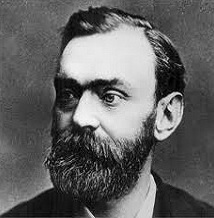Alfred Nobel Inventor of Dynamite

Biography of Alfred Nobel
Early Life
Alfred Nobel inventor of dynamite was a Swedish scientist who was born in 1833 on 21 October in the Stockholm. His father was an engineer and explosive specialist and he had four sons. Alfred Nobel was his third son. He encouraged all his sons to make their career in field of mechanical engineering. Alfred Nobel was nine years old when his family migrated to Saint Petersburg and there his father started a personal business of torpedoes. Alfred Nobel got his early education from tutors teaching at his own home and studied chemistry specially. In the age of 18 years, he moved to USA and started studying chemistry under supervision of John Ericsson.
Contributions
After basic study in USA, he moved to Paris where he introduced an explosive liquid known as nitroglycerine. In 1947, his father’s business of ammunition failed and as a result they were depending upon earnings of their mother who was working in a grocery store. After this, Alfred Nobel involved him more in the research of explosives and he was trying to control the volatility of nitroglycerine so that it could become easily usable. He succeeded in controlling the explosiveness and aggression of it in 1863 in an experiment in which he used a gunpowder charge.
Achievements
In 1865, he invented a fulminate mercury detonator which is a very important and most necessary part and component of further bigger explosives. After this successful development, he set up his own laboratories in different cities e.g. Stockholm, Hamburg, New York and California. On the other hand, he was facing serious challenges which were about negative usages of his product and in which many people were killed. One of the major blasts happened in his own laboratory and in that accident his own brother Emil was included in causalities.
Inventor of Dynamite
After these accidents he was trying to invent such a thing which would be less explosive and as a result he invented dynamite in 1867. He invented many other important and more explosive materials and one of them was gelignite. In year of 1895, he signed his last will and in which he asked to issue yearly Nobel prizes to the scientist who do something great and remarkable in the fields of chemistry, biology, physics and other branches of science. The first prize of this series was awarded in 1901.
Death
This person who faced a lot of challenges throughout his career died on10 December 1896 because of a stroke. He lived for almost 63 years and died at Sanremo, Italy.


Leave a Reply